The LoneStar Kit Helicopter
The 90’s brought a myriad of new kit helicopter designs to the world market including Cobra Helicopter’s turbine powered Predator single seat helicopter and the Rotax powered Mustang kit helicopter, Augusto Cicare’s Angel CH7 kit helicopter, the Furia/Skylark plans built helicopter, the Mosquito ultralight kit helicopter and Masquito experimental helicopter from Belgium. There were also the well known Rotorway Scorpion and Exec helicopters, the little known Lonestar kit helicopter and the unfortunate but ever popular Mini 500 kit helicopter, just to name a few.
There was much to be said for and against the many new homebuilt helicopter releases hitting the aviation market in the USA – and elsewhere in the world. A lot of them were way before their time as the general public, although fascinated by them, were not ready to support their sales. Many vendors regretfully closed up shop causing some of the early and most innovative kit helicopter designs to be lost forever.
They were the pioneers of what is now a booming kit helicopter industry around the world. Since then, modern technology has enabled lighter and more powerful engines and building materials creating more viable helicopter models to be produced and also the ability for individuals to build a helicopter from plans.
I have been following these smaller helicopter designs ever since my early teens when my father took me for a joy flight in a Hughes 500. I started buying every set of helicopter plans and information pack available (usually found in the back of Popular Mechanics magazines) and subscribed to most of the US based experimental aircraft magazines. Some of this valuable information though was lost over the years of moving house to house.
It wasn’t long before I came across the little known compact helicopter, the Lonestar Kit Helicopter, developed in Texas by Ken Rehler of Star Aviation Inc., which began production in March 1990. In July the first Lonestar kit helicopter prototype was displayed at the 28th Annual Popular Rotorcraft Association Convention, where it received a PRA award.
It sported modern McCutchen composite rotor blades, an aircraft grade 4130 chromoly airframe with standard swash plate and fly bar servo blade rotorhead, vertical mounted Rotax 582 engine and a wheeled tricycle style landing gear.
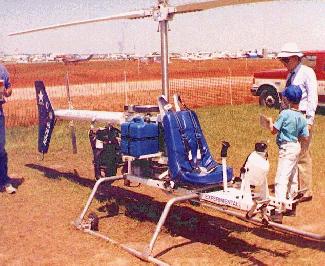
The LoneStar homebuilt helicopter on display at Oshkosh International Airshow in the USA
The first prototype LoneStar kit helicopter had a unique feature of having the tail rotor not extend past the main rotor disk diameter as did the early Adams Wilson ‘Flying Triumph’ also known as the “Choppy” of the 1950’s, including some of its offspring’s such as the AW95 and first SkyTwister helicopters.
This feature, amongst others was touted by the late B.J. Schramm of Rotorway fame as being unstable and having transitional flight problems, but fortunately this proved to be unfounded in real flight tests. While it remained a little “twitchy” in hover due to the short tail boom leverage, it was little different in control to that of an Robinson R22 helicopter. This Lonestar first flew on October 18, 1990.
The designers now with a proof of concept rotorcraft, set out to further improve upon their cute little chopper and put it into limited production runs. The first kit parts were shipped to customers in the summer of 1991. The original model (through Kit 36), was produced until April 1992 when production began on the current aluminum bolt-together frame model.
The final design was all aluminum framed with clean lines sporting a more powerful and reliable force-air cooled Hirth F30 two stroke engine rated at 95 hp providing ample power and improved performance. Simple layout for easy inspection and low maintenance components were also incorporated.
Other changes included a more stable through shaft control system (the inspiration behind the Mosquito ultralight helicopters swash plate system), elastomeric main rotor thrust bearings – much the same as early Rotorway Exec helicopters, new standard styling skid landing gear, a poly chain cog belt tail rotor drive eliminating slipping V-belt drives and expensive, heavy gearbox drive systems.
Star Aviation’s demonstration helicopter sporting all updates and improvements was completed in March 1993 and in October it received the “1993 Best Rotorcraft Award” at the Experimental Aircraft Association Southwest Regional Fly-in.
Star Aviation was on a winner with a brilliant new kit helicopter design when devastation struck. After successfully delivering only a small number of kits, their factory was completely destroyed in severe floods losing all stock, production equipment and original production drawings. To add to this, the Mini 500 helicopter had just been released and proved heavy competition due to it’s slick marketing and visual design.
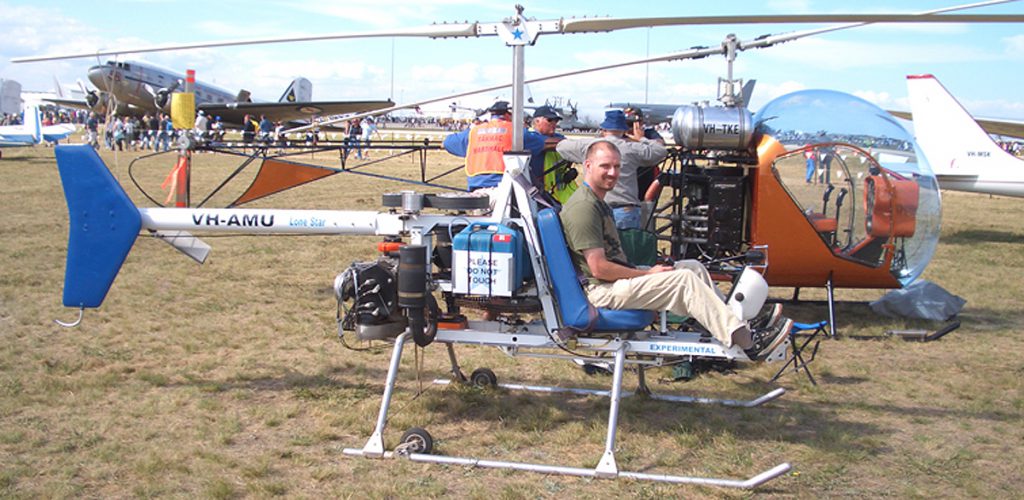
The LS-50 LoneStar Kit Helicopter at the Avalon Airshow, Australia (with Safari helicopter in background).
The decision was made to return to the 9 to 5 grind, as starting from scratch again didn’t seem like a viable option. Fortunately their prototype that was mainly used for air displays, wasn’t involved in the floods and continued to build 70 plus hours of flight time before being put up for sale.
It was an outback station owner in Quilpie, Queensland that was the lucky recipient of the LoneStar LS-50 kit helicopter with all factory upgrades and modifications including the upper frame change to improve rotor shaft support and stability.
Unfortunately, due to poor health the station owner was only able to add another 18 hours on the clock, mainly through monthly run-ups with the occassional hover around the patch. I had been fascinated for years with this particular craft due to its compact size and innovative design features.
I had been fortunate in obtaining an information pack for the LoneStar helicopter early in the 90’s during direct correspondence with Ken and was obsessed with finding one. I was also fortunate in that Ken had sent me some of the original manufacturing drawings before the flood damage.
It was quite by accident that I picked up the commercial Aviation Trader newspaper to round off a credit card purchase when I came across a Lonestar kit helicopter for sale here in Australia. I couldn’t believe my eyes! I immediately rang and claimed the craft as ‘sold’. My (then) wife and I flew to Brisbane (1,032 miles away) where we hired a Ford one-ton tray back Ute and left for Quilpie, west of Charleville in Queensland (another 610 miles where we found friendly people and great local pub!).
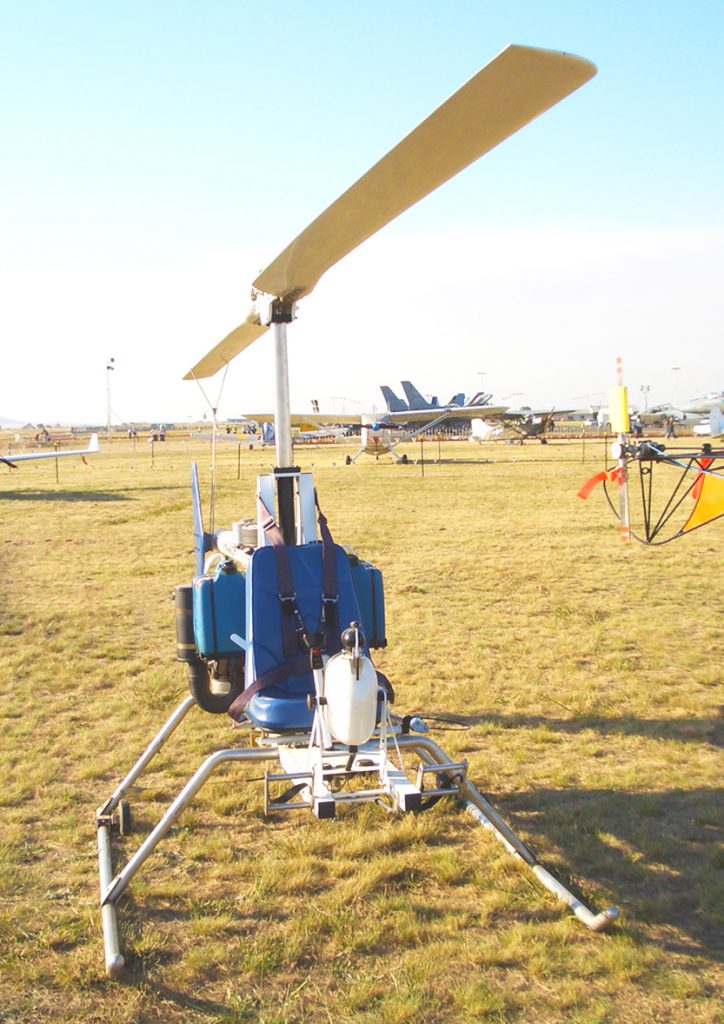
The sleek looking LoneStar helicopter kit with saddle tanks and smooth composite rotor blades clearly visible.
The 966 mile trip home in itself was another story but needless to say, after some very strange looks by fellow motorists, we got the LoneStar kit helicopter home safely to our home town in Victoria. Other than some minor cleaning and checking she was ready to go. It didn’t take us long to realise that the LoneStar helicopter purchase may have been a little premature since I have only a fixed wing RAA ultralight fixed wing licence with only a few helicopter hours, and was yet to complete my rotary wing training.
As the new experimental helicopter licensing requirements were not yet in effect in Australia, I would require a full helicopter PPL to fly and had just invested my funds in the LoneStar Kit Helicopter.
It was with regret that I decided to sell the Lonestar helicopter in an effort to fund my rotary wing licence ambitions, although I am happy to say that I once owned a Star Aviation LoneStar Kit Helicopter and had the chance to study this magnificent little machine.
| SPECIFICATIONS | |
|---|---|
| Engine | HIRTH F-30-EP2 |
| Horsepower | 95 hp @ 5,600 rpm |
| Main Rotorblades | McCutchen Composite |
| Main Rotor Diameter | 20 ft |
| Main Rotor RPM | 523 |
| Tail Rotor Diameter | 3 ft 9 inches |
| Tail Rotor RPM | 2843 |
| Fuel Capacity | 16 gallons (approx 62 litres) |
| Fuel Consumption | 5.5 gph (21 litres/hr) |
| Empty Weight | 470 lbs (210 kgs) |
| Gross Weight | 920 lbs (415 kgs) |
| Rate Of Climb | 1,000 fpm; |
| Cruise Speed – (no cabin) | 65 mph (105 kmph) |
| Maximum Speed – (with cabin) | 75 mph (120 kmph) |
| Top Speed (VNE) | 100 mph (160 kmph) |
| HIGE | 6,000 ft (1,830 m) |
| HOGE | 5,000 ft (1,525 m) |
| Service Ceiling | 9,500 ft (2895 m) |
| Length | 13 feet 5 inches |
| Width | 5 feet |
| Height | 7 feet 4 inches |
Footnote – The Lonestar Kit Helicopter
In hindsight, after studying the Lonestar helicopter – it was in need of further development to bring it up to a real performer. Firstly the bolt-together aluminum airframe allowed for to much movement causing misalignment of the drive system. A major concern though a relatively easy fix. Also noticed was the poor machining standards and finishes of some items, mainly being the drive shafts and main rotor shaft.
To add was the unsupported reduction drive shafts, much like the Rotorway Exec secondary shafts – and we all know what happened there. Again, though there were a few issues, all were rectifiable. The one design feature I never understood was to use sintered brass bushings for the main rotor head teeter mount instead of the more traditional roller or ball bearings. It was also noted that the rotor head cheek plates were not machined in pairs and thus had some serious miss-alignment issues.






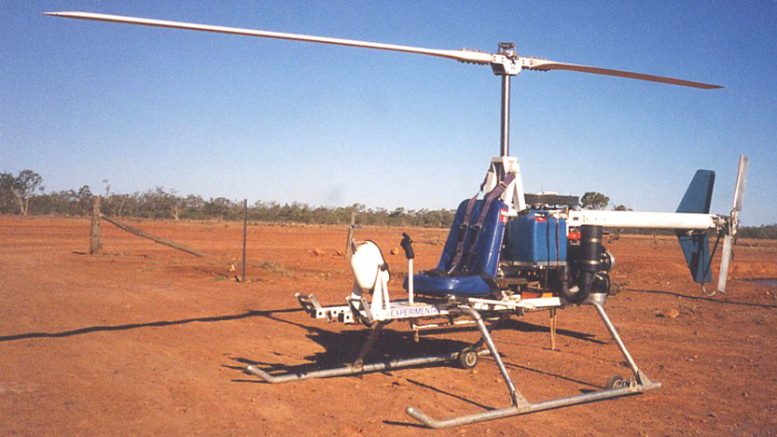
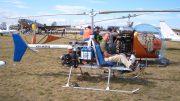
Be the first to comment on "LoneStar Kit Helicopter – Single Seat Personal Helicopter"